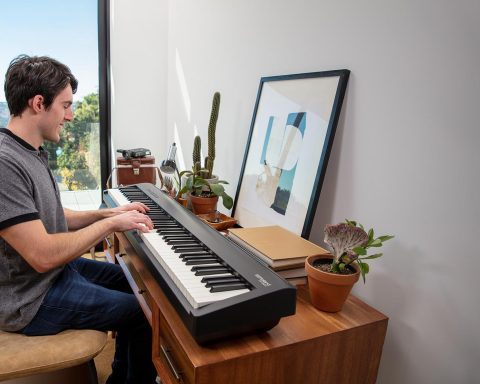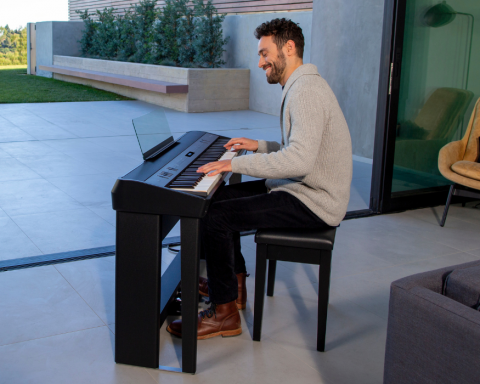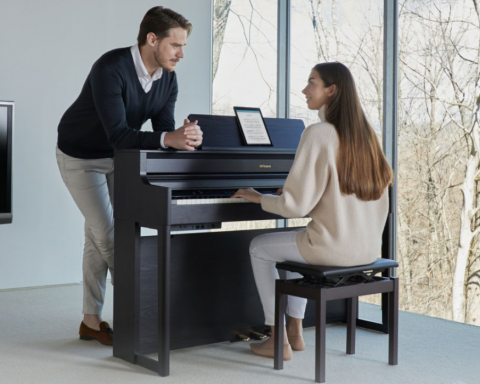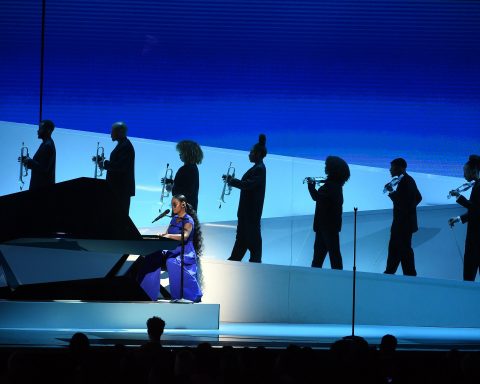Since 1973, Roland has consistently pushed the envelope of electronic piano innovation. The company balances its drive for ever-greater realism and the urge to explore fresh sound and design territories with respect for the legacy of traditional pianos. It’s been a high-wire balancing act, and one Roland has managed to walk for most of its 50-year history. Let’s take a look at some of the highlights of Roland’s accomplishments in digital pianos. Plus, get a sneak peek of an enticing new model sure to excite piano players of all levels.

A Series of Firsts
Bartolomeo Cristofori, an employee of the Medici Family, is the master builder credited with inventing the piano. The piano improved on the harpsichord and clavichord by employing hammers to strike the strings. This approach combined dynamics with sustain and volume, allowing for a new level of expressiveness. The instrument’s early Italian name of pianoforte, or soft-loud, highlighted this.
Fast forward 300 years to 1972, to the founding of Roland in Osaka, Japan. In 1973, along with two synthesizers (the SH-1000 and SH-3), Roland released Japan’s first electronic pianos: the analog EP-10 and EP-20. They were sturdy and reliable—a solid start for the company’s piano division.
Dynamic Innovation
The following year, Roland followed up the EP-10 with the EP-30. It was another breakthrough: the velocity-sensitive electronic piano. This time it was a first in Japan and the entire world. While electronic pianos were still far from sounding like acoustics, players could at last express themselves dynamically. That was what Bartolomeo Cristofori wanted, after all.
The tone and the extras may have surprised Cristofori, however. With its four preset sounds (two pianos and two harpsichords) plus a bass sound, the EP-30 provided useful tones for gigging rock musicians. Those who desired a more acoustic-like experience would have to wait for technology to catch up. They needn’t have worried. Roland’s tireless engineers were busy in the lab designing the future.
"The EP-30 was another breakthrough: the velocity-sensitive electronic piano. This time it was a first in Japan and the entire world."
Strides Forward
Innovations in Roland electronic pianos continued apace. As the ’70s became the ’80s, new styles emerged. Coupled with technological breakthroughs, these allowed for previously unimagined variations.
We rarely consider pianos portable instruments. Roland took what was large and unwieldy and made it lightweight with the EP-11 Piano Plus 11. The EP-11 was a fun electric piano with a built-in speaker and analog drum machine.
MIDI was the talk of the musical town in 1983. Musical Instrument Digital Interface was a protocol developed by Roland and Sequential Circuits. MIDI allowed electronic instruments from different manufacturers to talk to each other. That same year, Roland released the HP-300 and HP-400, the first home pianos with MIDI. Their two-piece cabinet design—main body and stand—became the industry standard.
The Digital Revolution
We’ve avoided using the term digital piano up to this point because, while digital components were in these instruments, the sound synthesis was analog. Everything changed in 1986 with the RD-1000 Stage Piano. This groundbreaking instrument set the stage for the next generation of electronic pianos.

"Everything changed in 1986 with the RD-1000 Stage Piano. This groundbreaking instrument set the stage for the next generation of electronic pianos."
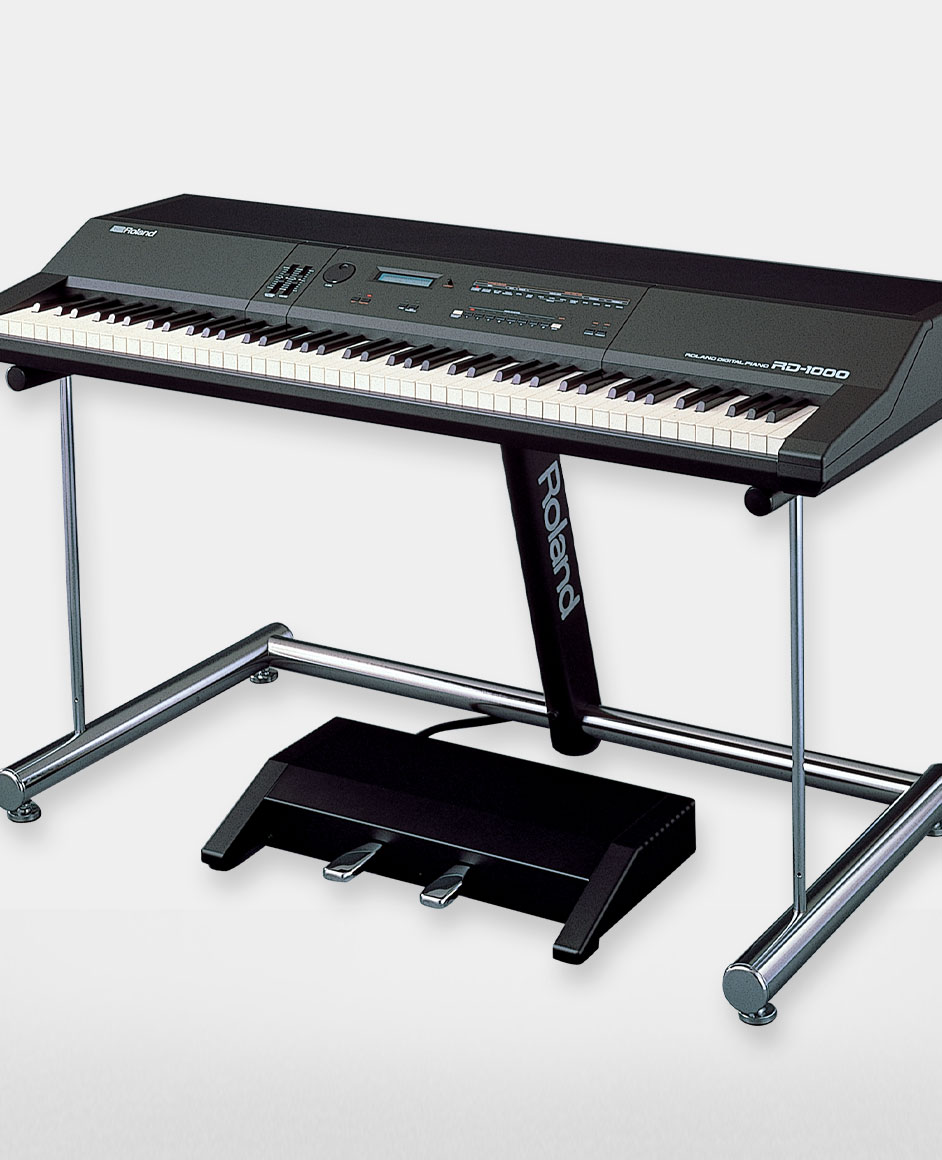
The RD-1000 was an immediate hit. Elton John famously took it on tour with him, playing it worldwide. It was so successful that Roland decided to open a dedicated factory in Hamamatsu, Japan. The company finally moved its headquarters to the sleepy lakeside town, something it had been interested in for years.
By the mid-1980s, digital synthesis was well-established in the world of electronic instruments. Drum machines and synthesizers benefitted greatly from the new paradigm. Roland saw the potential for using digital—particularly samples—to bring a new element of realism to electronic pianos. However, basic sample playback couldn’t capture a musician’s nuances or the intricacies of an instrument. As a result, Roland developed Structured Adaptive Synthesis.
After more than a year in development, lead engineer (and later Roland CEO) Jun-ichi Miki recreated the many aspects of a piano. SA Synthesis used samples as a base but employed an algorithm to resynthesize each note’s various harmonics, overtones, and noises. It was a revelation, starting a digital revolution. Roland carried many of these concepts into future synthesis architectures.
"V-Piano was a radical reinterpretation of a piano's potential. By digitally modeling all aspects of the piano, the instrument emerged as independent in form and function."
Unparalleled Realism
Structured Adaptive Synthesis wasn’t limited to the RD-1000 Stage Piano. It soon made its way into home pianos, including the HP-5500 and HP-5600. The sound was so realistic that acoustic piano manufacturers started worrying that Roland’s creations would cut into their business.
How realistic was Structured Adaptive Synthesis? Roland felt its digital pianos were real musical instruments, not mere substitutes for acoustic pianos. To prove this, in 1991, it sponsored a performance at Tokyo Suntory Hall with a full acoustic orchestra. Instead of an acoustic piano, Roland provided the HP-7700. The concert was a resounding success.
Concepts Approaching Perfection
Like the violin, people have considered the piano a perfect instrument for the past 300 years. How does one improve upon perfection? If constrained by the limitations of physical reality, you can’t. But if one approaches this challenge digitally, it becomes possible to reinvent the piano. That’s what happened with V-Piano in 2009.
V-Piano was a radical reinterpretation of a piano’s potential. By digitally modeling all aspects of the piano, the instrument emerged as independent in form and function. Size and shape no longer mattered; players could even change string material. The technology set the piano free.
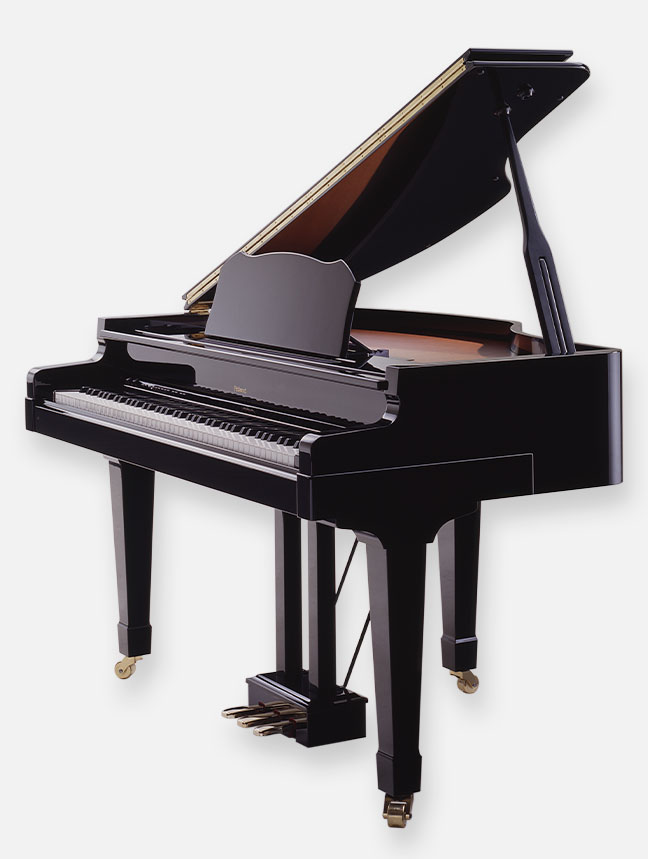
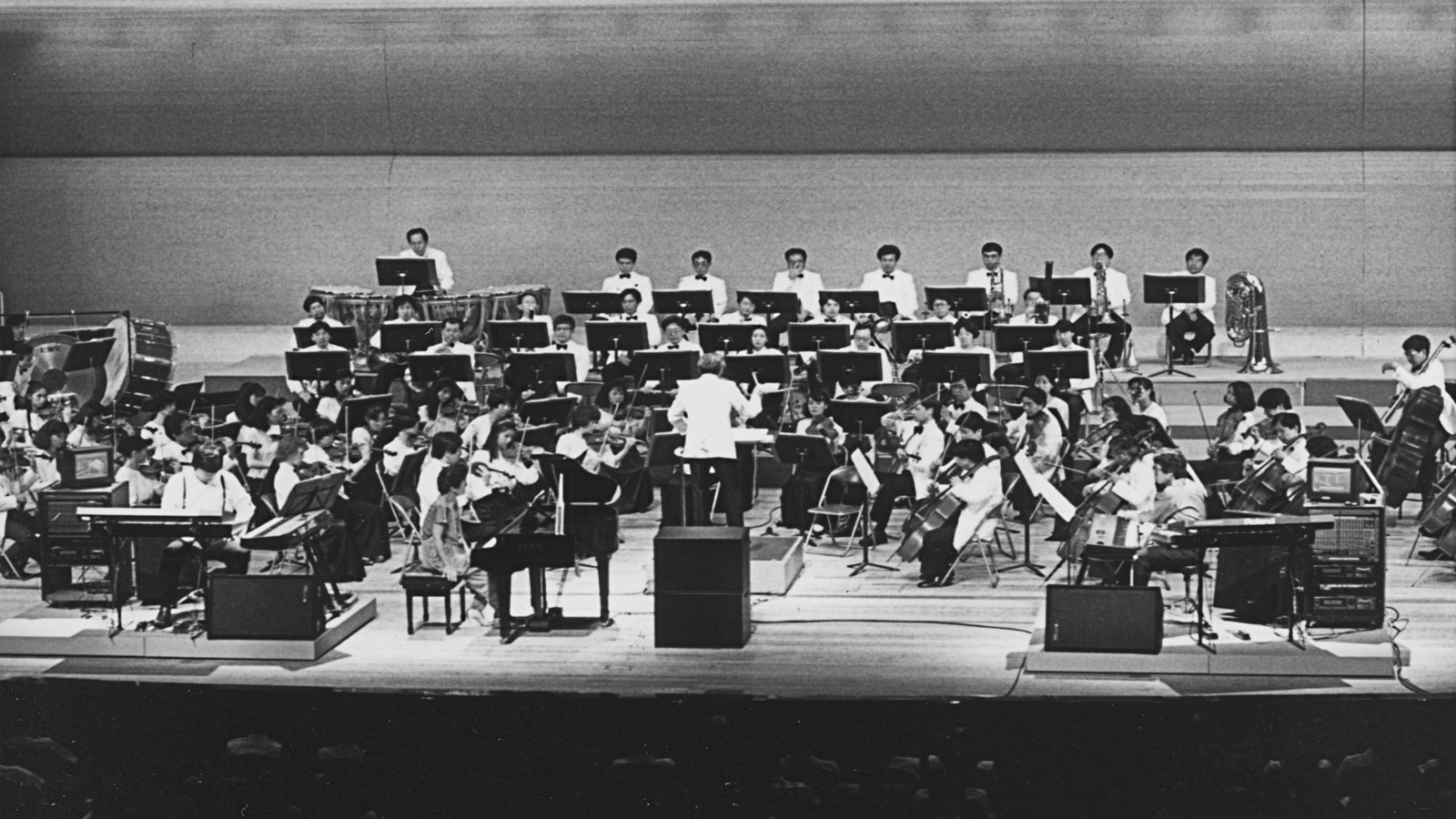
"Japanese classical pianist Yukio Yokoyama famously declared if Bach or Mozart had access to the V-Piano, they'd have written their famous works very differently."

Rather than use PCM sampling, V-Piano uses a different approach, as former engineer Tadao Kikumoto explains. This “combines components of uncorrelated but essential sound to create synergistic effects.” For example, it models the strings and the thump of the frame and body. Players can create a strikingly realistic piano sound by separating and modeling them into partials and then recombining them.
Achieving Balance
“V-Piano has a silver string sound program,” Kikumoto reveals. “In reality, even if you were to make a string with silver, the specific gravity of silver is heavier than copper. “So the hammer that hits the string would have to be larger, and the key touch would become so heavy that the piano could not be played.” However, the V-Piano can achieve this tone, producing a heavy, thick, glittering sound.
Getting the balance right between these elements was a challenge for the engineers. “It was difficult to analyze the sound to separate it into the components that make it up,” Kikumoto explains. Difficult but worth it. The realism of the V-Piano astonished many professional piano players. Japanese classical pianist Yukio Yokoyama famously declared if Bach or Mozart had access to the V-Piano, they’d have written their famous works very differently.
"The KIYOLA KF-10 was a collaboration with Karimoku, a Japanese hand-made wooden furniture brand. The instrument is sold in the New York Museum Of Modern Art (MoMA)."
Making Musical Art
One of Roland’s most famous catchphrases is, “We design the future.” While this slogan no doubt refers to the circuits inside the products, one can apply it to the look of its instruments and effects. Case in point: the KIYOLA KF-10. This 2015 digital piano was a collaboration with Karimoku, a Japanese hand-made wooden furniture brand. Inside, it’s a Roland digital piano powered by SuperNATURAL Piano Modeling. On the outside, it’s a gorgeous, hand-made, all-natural piece of art. In fact, the New York Museum Of Modern Art (MoMA) likes it so much it sells the KIYOLA KF-10 on its store website.
According to Karimoku, inspiration for the sleek, understated design began by considering the electronic piano market and customer voices. They then brainstormed with Roland about proposals for wooden frames. “We aimed for a design that naturally blends into your life as part of the interior,” Takahiko Fujimori from Karimoku explains. “Like an armchair that is fun to look at. For that reason, we conducted extensive research and development on a structure in which the heavy keyboard and the housing containing the electronic unit get sandwiched by a slim frame.”
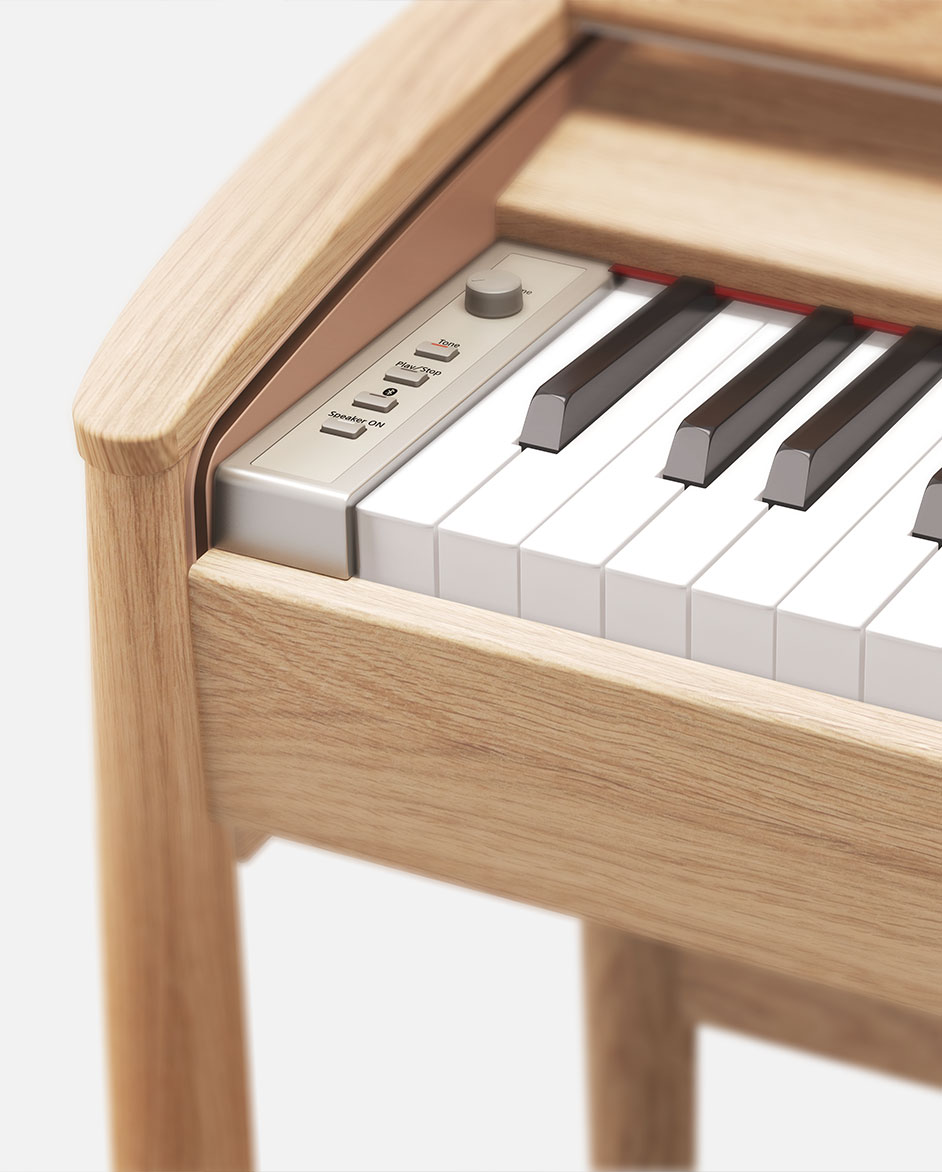
"When playing the piano, we would like you to experience the joy of concentration and creativity. At the same time, we hope that you feel the warmth of the wood and have a pleasant experience."
Takahiko Fujimori
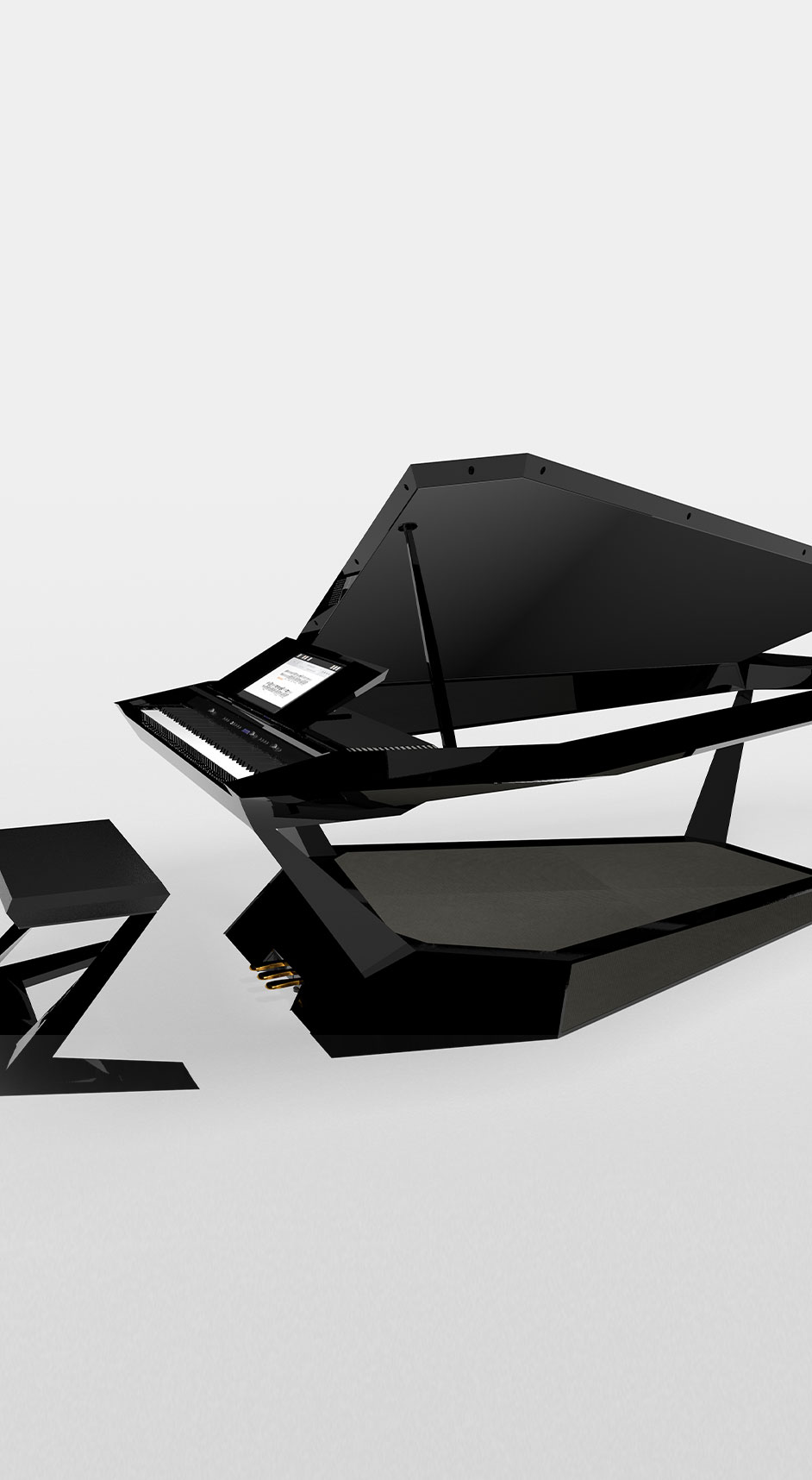
The Joy of Creativity
Of course, the KIYOLA is for more than admiring from afar. It’s designed for musicians to play. “When playing the piano,” Fujimori stresses, “we would like you to experience the joy of concentration and creativity. But at the same time, we hope that you feel the warmth of the wood and have a pleasant experience.”
The KIYOLA KF-10 is not the only digital piano in Roland’s history that has received accolades for its appearance. The HP704 (2019) received the Good Design Award from the Chicago Athenaeum Museum of Architecture and Design, while 2021’s F701 was a Red Dot Design Award winner. In addition, the LX-700 series won an international design award, the iF Design Award in 2019, and a Red Dot Design Award in 2019.
What is Classic?
Take a glance at 2020’s GPX-F1 Facet Grand Piano, and you’ll know you’re in the presence of something special. Angular and minimal yet open and inviting, the Facet Grand is a bold reinvention of what a classical grand piano should look like. Leave it to Roland to produce such a bold take on the piano.
This piano began with the Digital Piano Design Awards in 2015. Winner Jong Chan Kim from South Korea based his design on naturally occurring polyhedrons. The name Facet reflects these crystalline structures.
Of course, it’s more than a pretty frame. Inside the Facet were optimized versions of Roland’s PureAcoustic Piano Modeling and a multi-speaker Acoustic Projection system. These do away with the need for the kind of resonating wooden chamber found in acoustic pianos. It also has an Android-compatible display for digital scores, lesson support for piano apps and YouTube, and music creation support via Zenbeats. There is also Amazon’s Alexa for voice control to play music. Very modern, indeed.
"The Facet will be soaking up all the light on stage because it's so beautiful. It looks like something from the alien opera in The Fifth Element."
John Grant
A Modern Icon
While not available for general sale, many artists have used the striking instrument in performances. R&B singer H.E.R. sat behind the Facet during the 2020 Grammy Awards, with the design reflecting her powerful performance. Musician John Grant played the Facet at Grace Jones’ Meltdown Festival. He praised the grand piano, saying, “The Facet will be soaking up all the light on stage because it’s so beautiful. It looks like something from the alien opera in The Fifth Element.”
Summing up his love for Roland’s digital pianos, Grant added, “Roland pianos sound and feel like pianos. That’s why I enjoy playing them so much. I don’t want to get thrown out of the creative process by feeling like I’m not playing or hearing what I think I should be.”
Never Stop Evolving
Fifty years is a long time to be in business, so it’s fitting that Roland should want to celebrate and look back at its past milestones. However, Roland does design the future. Accordingly, the company has been working on a unique 50th Anniversary Concept Model piano. The model highlights where Roland pianos have been and where they are going. Or, as Yoshiyasu Kitagawa, the Piano Development Division Head, says, “We would like our customers to expect that Roland and our pianos will never stop evolving.”
The new conceptual instrument celebrates the entirety of the history of Roland pianos. “In this 50th Anniversary Concept Model, we’ve developed and installed cutting-edge sound field realization technology,” he says. “Beginning with the EP-10, we installed sounds from 1973, the RD-1000, JD-800, V-Piano, SuperNATURAL, and other historical sounds. This allows you to relive the evolution of technology since the introduction of the digital piano in 1973.”

"Beginning with the EP-10, we installed sounds from 1973, the RD-1000, JD-800, V-Piano, SuperNATURAL, and other historical sounds. This allows you to relive the evolution of technology."
Yoshiyasu Kitagawa

Still, it’s not merely recreations of past triumphs. The new model is the culmination of Roland’s astonishing advancements. “Based on the PureAcoustic Modeling technology announced in 2018,” explains Kitagawa. “We have continued to refine our modeling technology through the Facet in 2020. More complex and advanced modeling calculations and multi-channel speakers create a realistic piano sound. We also developed an innovative keyboard sensing algorithm (patent pending). As a result, we have achieved a keyboard touch that provides a more natural response than ever before.” This natural response extends to the pedal, with a faithful reproduction of the noise that the physical mechanism creates.
Facing Challenges
The new model was not without its challenges. Incorporating the legacy instruments was particularly difficult, given they all come from different eras of Roland’s history and synthesis models. They also had to sound natural through the sound field of the new unit. “It was difficult to recreate the tone of the time,” remembers Takahiro Murai, General Manager of Roland Keyboard Instrument Development dept. However, the team was able to do it “through trial and error, based on the opinion of a legendary engineer who knew the original sounds.”
The unique wooden body of the 50th Anniversary Concept Model also presented some difficulties. “The cabinet, which is formed as a single body,” says Murai, “is extremely rigid. We could realize a speaker driver faithful to the original sound. This was a great help in creating the expected tone and sound field.” To make sure the cabinet was just right, Roland once again called upon the assistance of the furniture company, Karimoku.
"The 50th Anniversary Concept Model has the acoustic performance of a grand piano and a shape that suits it—a round shape that does not fit against the wall or in the corner of the room."
Takahiro Murai
A Grand Piano for Tomorrow
Where the concept behind 2015’s KIYOLA was an interior piano to improve the quality of life, the 50th Anniversary Concept Model idea is a little loftier. This model is a home grand piano of the future, filled with past creativity and future possibilities. If you look at the model in question, you’ll know that Roland and Karimoku have hit it right on the head. Smooth and flowing, traditional in its use of materials and yet utterly modern in form, it inspires the player’s eyes, ears, and fingers. “The 50th Anniversary Concept Model has the acoustic performance of a grand piano and a shape that suits it—a round shape that does not fit against the wall or in the corner of the room,” Murai adds.
Tradition Meets Ultra-Modern
The construction of the concept model itself embodies the idea of the past and future coming together as one. “In contrast to KIYOLA, which comes from assembled parts, we created the new model by machine-cutting layers of small wooden pieces from digital data and stacking them to shape a single body,” Fujimori adds. “We incorporated the concept of 3D printing, in which cross sections are made with high accuracy and layered, and the ancient method of manufacturing Buddhist statues based on the characteristics of wood movement, etc.”
"We want users to get past the digital and acoustic concept and enjoy the natural performance and beauty purely as a piano."
Yoshiyasu Kitagawa

SDGs, or Sustainable Development Goals, are at the heart of the design, which has always been important to Karimoku. The new model uses Japanese Nara oak wood from Hokkaido, as oak is hard and heavy. However, Karimoku used already cut, small-diameter oak, mainly used as raw material for paper. This ensures that the model can be repaired when needed and not discarded like many modern electronics.
Moving Forward
“We want users to get past the digital and acoustic concept and enjoy the natural performance and beauty purely as a piano,” Kitagawa says. “And we want the users to experience the advances of technology from the past to the present and the future.” To that end, the 50th Anniversary Concept Model will tour the world along with a revolutionary new sound system that must be heard and seen to be believed. After all, the future doesn’t end, so Roland’s new concepts don’t either. They’re always designing the future.


